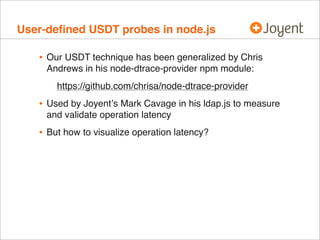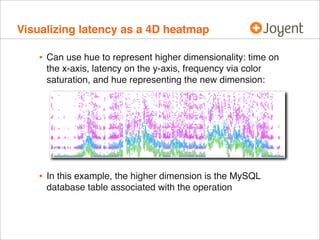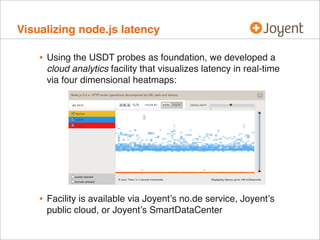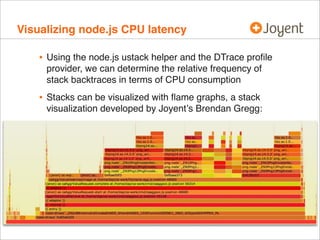Instrumenting the real-time web: Node.js in production
- 1. Instrumenting the real-time web: Running node.js in production Bryan Cantrill VP, Engineering [email protected] @bcantrill
- 2. “Real-time web?” • The term has enjoyed some popularity, but there is clearly confusion about the definition of “real-time” • A real-time system is one in which the correctness of the system is relative to its timeliness • A hard real-time system is one which the latency constraints are rigid: violation constitutes total system failure (e.g., an actuator on a physical device) • A soft real-time system is one in which latency constraints are more flexible: violation is undesirable but non-fatal (e.g., a video game or MP3 player) • Historically, the only real-time aspect of the web has been in some of its static content (e.g. video, audio)
- 3. The rise of the real-time web • The rise of mobile + HTML5 has given rise to a new breed of web application: ones in which dynamic data has real-time semantics • These data-intensive real-time applications present new semantics for web-facing applications • These present new data semantics for web applications: CRUD, ACID, BASE, CAP — meet DIRT!
- 4. The challenge of DIRTy apps • DIRTy applications tend to have the human in the loop • Good news: deadlines are soft — microseconds only matter when they add up to tens of milliseconds • Bad news: because humans are in the loop, demand for the system can be non-linear • One must deal not only with the traditional challenge of scalability, but also the challenge of a real-time system!
- 5. Building DIRTy apps • Embedded real-time systems are sufficiently controlled that latency bubbles can be architected away • Web-facing systems are far too sloppy to expect this! • Focus must shift from preventing latency bubbles to preventing latency bubbles from cascading • Operations that can induce latency (network, I/O, etc.) must not be able to take the system out with them! • Implies purely asynchronous and evented architectures, which are notoriously difficult to implement...
- 6. Enter node.js • node.js is a JavaScript-based framework for building event-oriented servers: var http = require(‘http’); http.createServer(function (req, res) { res.writeHead(200, {'Content-Type': 'text/plain'}); res.end('Hello Worldn'); }).listen(8124, "127.0.0.1"); console.log(‘Server running at http://127.0.0.1:8124!’);
- 7. node.js as building block • node.js is a confluence of three ideas: • JavaScriptʼs rich support for asynchrony (i.e. closures) • High-performance JavaScript VMs (e.g. V8) • The system abstractions that God intended (i.e. UNIX) • Because everything is asynchronous, node.js is ideal for delivering scale in the presence of long-latency events!
- 8. The primacy of latency • As the correctness of the system is its timeliness, we must be able to measure the system to verify it • In a real-time system, it does not make sense to measure operations per second! • The only metric that matters is latency • This is dangerous to distill to a single number; the distribution of latency over time is essential • This poses both instrumentation and visualization challenges!
- 9. Instrumenting for latency • Instrumenting for latency requires modifying the system twice: as an operation starts and as it finishes • During an operation, the system must track — on a per- operation basis — the start time of the operation • Upon operation completion, the resulting stored data cannot be a scalar — the distribution is essential when understanding latency • Instrumentation must be systemic; must be able to reach to the sources of latency deep within the system • These constraints eliminate static instrumentation; we need a better way to instrument the system
- 10. Enter DTrace • Facility for dynamic instrumentation of production systems originally developed circa 2003 for Solaris 10 • Open sourced (along with the rest of Solaris) in 2005; subsequently ported to many other systems (MacOS X, FreeBSD, NetBSD, QNX, nascent Linux port) • Support for arbitrary actions, arbitrary predicates, in situ data aggregation, statically-defined instrumentation • Designed for safe, ad hoc use in production: concise answers to arbitrary questions • Particularly well suited to real-time: the original design center was the understanding of latency bubbles
- 11. DTrace + Node? • DTrace instruments the system holistically, which is to say, from the kernel, which poses a challenge for interpreted environments • User-level statically defined tracing (USDT) providers describe semantically relevant points of instrumentation • Some interpreted environments (e.g., Ruby, Python, PHP, Erlang) have added USDT providers that instrument the interpreter itself • This approach is very fine-grained (e.g., every function call) and doesnʼt work in JITʼd environments • We decided to take a different tack for Node
- 12. DTrace for node.js • Given the nature of the paths that we wanted to instrument, we introduced a function into JavaScript that Node can call to get into USDT-instrumented C++ • Introduces disabled probe effect: calling from JavaScript into C++ costs even when probes are not enabled • We use USDT is-enabled probes to minimize disabled probe effect once in C++ • If (and only if) the probe is enabled, we prepare a structure for the kernel that allows for translation into a structure that is familiar to node programmers
- 13. Node USDT Provider • Example one-liners: dtrace -n ‘node*:::http-server-request{ printf(“%s of %s from %sn”, args[0]->method, args[0]->url, args[1]->remoteAddress)}‘ dtrace -n http-server-request’{@[args[1]->remoteAddress] = count()}‘ dtrace -n gc-start’{self->ts = timestamp}’ -n gc-done’/self->ts/{@ = quantize(timestamp - self->ts)}’ • A script to measure HTTP latency: http-server-request { self->ts[args[1]->fd] = timestamp; } http-server-response /self->ts[args[0]->fd]/ { @[zonename] = quantize(timestamp - self->ts[args[0]->fd]); }
- 14. User-defined USDT probes in node.js • Our USDT technique has been generalized by Chris Andrews in his node-dtrace-provider npm module: https://github.com/chrisa/node-dtrace-provider • Used by Joyentʼs Mark Cavage in his ldap.js to measure and validate operation latency • But how to visualize operation latency?
- 15. Visualizing latency • Could visualize latency as a scalar (i.e., average): • This hides outliers — and in a real-time system, it is the outliers that you care about! • Using percentiles helps to convey distribution — but crucial detail remains hidden
- 16. Visualizing latency as a heatmap • Latency is much better visualized as a heatmap, with time on the x-axis, latency on the y-axis, and frequency represented with color saturation: • Many patterns are now visible (as in this example of MySQL query latency), but critical data is still hidden
- 17. Visualizing latency as a 4D heatmap • Can use hue to represent higher dimensionality: time on the x-axis, latency on the y-axis, frequency via color saturation, and hue representing the new dimension: • In this example, the higher dimension is the MySQL database table associated with the operation
- 18. Visualizing node.js latency • Using the USDT probes as foundation, we developed a cloud analytics facility that visualizes latency in real-time via four dimensional heatmaps: • Facility is available via Joyentʼs no.de service, Joyentʼs public cloud, or Joyentʼs SmartDataCenter
- 19. Debugging latency • Latency visualization is essential for understanding where latency is being induced in a complicated system, but how can we determine why? • This requires associating an external event — an I/O request, a network packet, a profiling interrupt — with the code thatʼs inducing it • For node.js — like other dynamic environments — this is historically very difficult: the VM is opaque to the OS • Using DTraceʼs helper mechanism, we have developed a V8 ustack helper that allows OS-level events to be correlated to the node.js-backtrace that induced them • Available for node 0.6.7 on Joyentʼs SmartOS
- 20. Visualizing node.js CPU latency • Using the node.js ustack helper and the DTrace profile provider, we can determine the relative frequency of stack backtraces in terms of CPU consumption • Stacks can be visualized with flame graphs, a stack visualization developed by Joyentʼs Brendan Gregg:
- 21. node.js in production • node.js is particularly amenable for the DIRTy apps that typify the real-time web • The ability to understand latency must be considered when deploying node.js-based systems into production! • Understanding latency requires dynamic instrumentation and novel visualization • At Joyent, we have added DTrace-based dynamic instrumentation for node.js to SmartOS, and novel visualization into our cloud and software offerings • Better production support — better observability, better debuggability — remains an important area of node.js development!
- 22. Thank you! • @ryah and @rmustacc for Node DTrace USDT integration • @dapsays, @rmustacc, @rob_ellis and @notmatt for cloud analytics • @chrisandrews for node-dtrace-provider and @mcavage for putting it to such great use in ldap.js • @dapsays for the V8 DTrace ustack helper • @brendangregg for both the heatmap and flame graph visualizations • More information: http://dtrace.org/blogs/dap, http://dtrace.org/blogs/brendan and http://smartos.org












![Node USDT Provider
• Example one-liners:
dtrace -n ‘node*:::http-server-request{
printf(“%s of %s from %sn”, args[0]->method,
args[0]->url, args[1]->remoteAddress)}‘
dtrace -n http-server-request’{@[args[1]->remoteAddress] = count()}‘
dtrace -n gc-start’{self->ts = timestamp}’
-n gc-done’/self->ts/{@ = quantize(timestamp - self->ts)}’
• A script to measure HTTP latency:
http-server-request
{
self->ts[args[1]->fd] = timestamp;
}
http-server-response
/self->ts[args[0]->fd]/
{
@[zonename] = quantize(timestamp - self->ts[args[0]->fd]);
}](https://image.slidesharecdn.com/nodesummit-120124182650-phpapp01/85/Instrumenting-the-real-time-web-Node-js-in-production-13-320.jpg)








